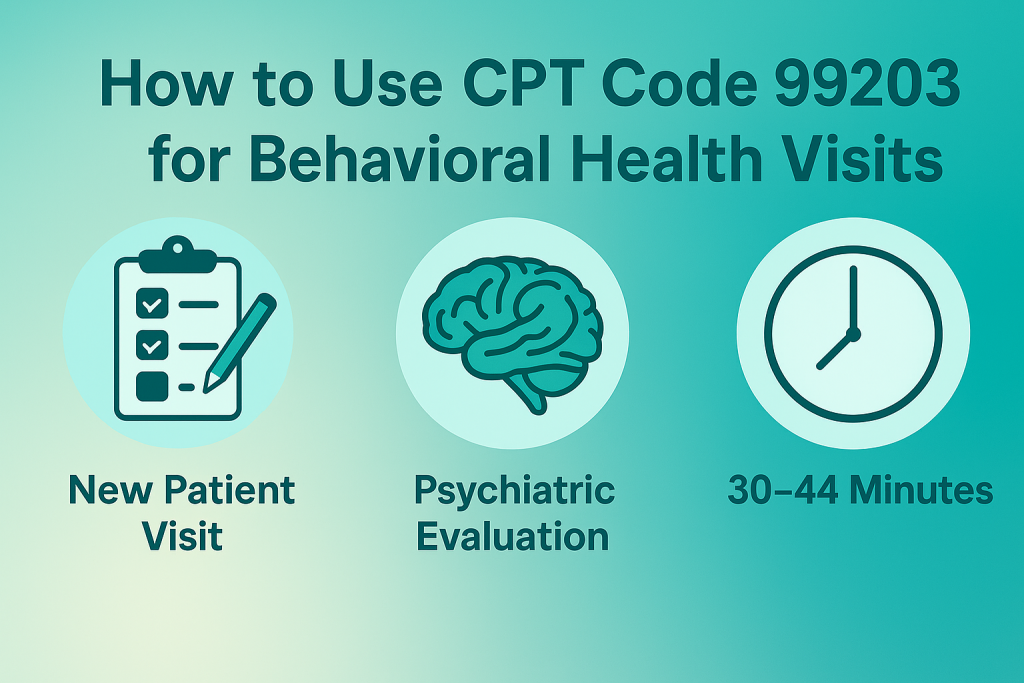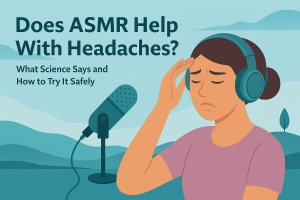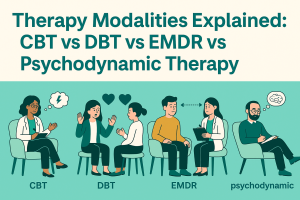How to Use CPT Code 99203 (Behavioral Health)
A practical, visual guide for psychiatrists and prescribers in mental health. Learn when 99203 fits, how to pick it by time (30–44 min) or low MDM, what to document, and how it compares with 90792—and with 99202/99204.
Quick context
What CPT 99203 means in psychiatry & med management
99203 is a new-patient E/M (Evaluation & Management) code used in the office or outpatient setting. You can select it by: total time on the date of the encounter (30–44 minutes), or by Medical Decision Making at a low level. In behavioral health, it’s most often used by prescribers (psychiatrists, PMHNPs, PAs). Non-prescribing therapists generally do not bill E/M codes.
Choosing 99203 by time vs MDM (visual)
You may select 99203 by either time (30–44 min) or by MDM (low) — not both.
99203 at a glance (infographic cards)
Patient has not received professional services from you (or same specialty in your group) within the last 3 years.
30–44 minutes total same-day time (qualifying pre-, intra-, post-visit tasks per E/M rules).
Low MDM (limited problems & data, low risk). Pick MDM only if better than time for your case.
Psychiatric intake when E/M is allowed, or new-patient med management with careful documentation.
Where 99203 sits (vs 99202 and 99204)
Straightforward MDM • 20–29 min
Brief new-patient encounter; low data review; minimal risk. Often too light for psychiatric intakes.
Low MDM • 30–44 min
Common for new psychiatric visits when E/M is used and complexity/time are modest.
Moderate MDM • 45–59 min
More complex assessment or higher data/risk profile; typical for complicated psychiatric intakes.
90792 vs 99203 for psychiatric intakes
90792 = Psychiatric diagnostic evaluation with medical services. Many payers prefer this for initial psychiatric assessments.
99203 = New-patient E/M. Acceptable with some payers for psychiatric intake if documentation supports E/M selection.
- Don’t double-bill 90792 and 99203 for the same work on the same day.
- If psychotherapy is also provided the same day, consider add-on codes (e.g., 90833) when permitted and separately documented.
- Therapists (non-prescribers) generally use 90791 for intake, not 99203.
Related reading: How to Write Therapy Intake Notes
Documentation checklist for 99203
For time-based selection, list qualifying activities done on the date of the encounter (review, obtain history, exam, counseling, ordering, documentation, care coordination) consistent with current E/M guidance.
Sharpen your clinical documentation: SOAP Notes • Progress Notes • Treatment Plans • Discharge Summaries
Real-world behavioral health examples
Time: 38 minutes same day (review referral & PMH, interval history, exam/MSE, counseling on sleep hygiene, documentation) MDM: Low (one stable chronic / acute uncomplicated; limited data; low risk) Plan: Trial SSRI; sleep hygiene; CBT referral; f/u in 3 weeks Code: 99203 (by time or low MDM)
Time: 31 minutes; baseline PHQ-9 = 14; prior med trials reviewed; no acute risk MDM: Low; limited data; low risk Plan: Restart prior SSRI; labs if indicated; safety plan reviewed Code: 99203 (time 30–44 min)
Time: 52 minutes; collateral from family; abnormal thought content MDM: Moderate; higher data and risk Plan: Antipsychotic initiation; close monitoring Code: 99204 (not 99203)
Common denials & how to avoid them
- Time not supported: If selecting by time, include the total minutes and qualifying activities on the date of the encounter.
- MDM mismatch: Low MDM documented but high-complexity code selected (or vice versa). Align problems, data, and risk.
- Wrong intake code for payer: Some payers expect 90792 for psychiatric diagnostic evaluations — verify policy.
- Medical necessity not clear: Tie assessment to functional impact and clinical decision making.
- Telehealth missing details: Document modality, consent, locations, and required modifiers/POS.
Standardize your psych documentation & coding
From intake (90792) to E/M selection and psychotherapy add-ons, we’ll help you design templates that match payer policy — without adding admin burden.
Talk to a Practice Consultant



